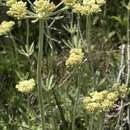fi
nimet breadcrumb-navigoinnissa


Eriogonum heracleoides (common names; parsnipflower buckwheat, whorled buckwheat, and Wyeth buckwheat[1]) is a plant of western North America that has many flowering clusters which are usually cream colored, or off-white. It can usually be found in rocky areas, such as sagebrush deserts and Ponderosa pine forests. Parsnipflower buckwheat is in the genus Eriogonum and the family Polygonaceae, which is a family of plants known as the "knotweed family". It inhabits much of the western part of the United States and southern British Columbia.[2][3]
The parsnipflower buckwheat is an erect herbaceous perennial plant rarely more than 40 cm (15+3⁄4 in) tall. Blooming early in the summer, its flowers measure 4–9 mm (1⁄8–3⁄8 in); these are pale yellow and redden with age.[4] The leaves are arranged in loose rosettes, covered with soft hairs measuring 5–30 mm (1⁄4–1+1⁄8 in). The hairs feel woolly and matted, and cover both sides of the leaf.[5] The flowers have one carpel (achene). The plant has a whorled arrangement of leaves at midpoint of the stem[6][7] as well as one beneath the base of the stems.[4] It blooms in early to mid summer. It attracts butterflies, bees, insects, and birds and is the host plant for several Palouse butterflies.[8]
Eriogonum heracleoides (common names; parsnipflower buckwheat, whorled buckwheat, and Wyeth buckwheat) is a plant of western North America that has many flowering clusters which are usually cream colored, or off-white. It can usually be found in rocky areas, such as sagebrush deserts and Ponderosa pine forests. Parsnipflower buckwheat is in the genus Eriogonum and the family Polygonaceae, which is a family of plants known as the "knotweed family". It inhabits much of the western part of the United States and southern British Columbia.
Eriogonum heracleoides là một loài thực vật có hoa trong họ Rau răm. Loài này được Nutt. mô tả khoa học đầu tiên năm 1834.[1]
Eriogonum heracleoides là một loài thực vật có hoa trong họ Rau răm. Loài này được Nutt. mô tả khoa học đầu tiên năm 1834.